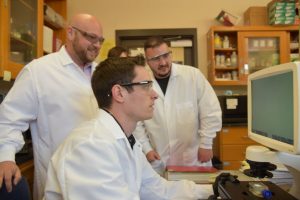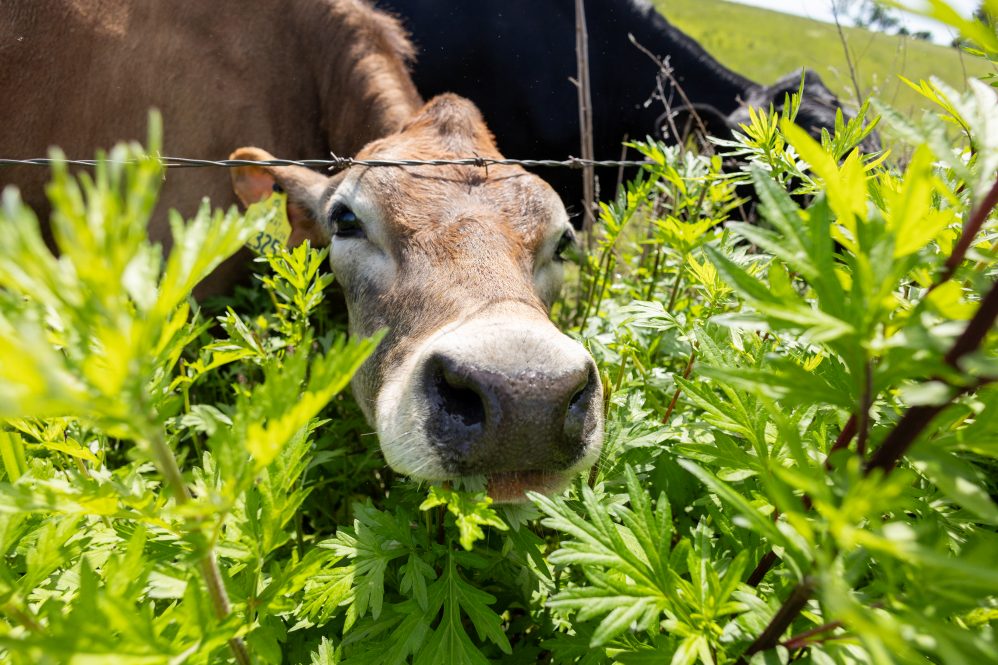Foot and Mouth Disease (FMD) is a devastating illness that impacts cloven-hoofed animals like cows and pigs. It was eradicated in the United States in 1929, and, thanks to strict prevention measures, there has not been another FMD case since. However, because the Foot and Mouth Disease Virus (FMDV) spreads so quickly and remains endemic elsewhere in the world, it would be extremely easy for an outbreak to happen here, says UConn Department of Pathobiology and Veterinary Science Associate Professor Steven Szczepanek ‘09 Ph.D.
Szczepanek and collaborators, including his student Aishwarya Mogulothu ‘25 Ph.D. and USDA Foreign Animal Disease Research Unit scientists Teresa de los Santos and Gisselle Medina, recently published their findings in the Journal of Virology on a potential new target for treating and stopping the spread of FMDV in the event of an outbreak.
“This is critical because FMD is one of the fastest replicating and spreading viruses known to man. It spreads from farm to farm extremely quickly. By the time you detect the virus on one farm, it’s likely already moved to adjacent farms, so it’s extremely challenging to control,” says Szczepanek.
Current control measures include mass culling programs, which Szczepanek warns would be economically catastrophic since the beef and pork industries are valued at hundreds of billions of dollars. Prevention through strict regulations remains the frontline defense against this disease.
“Many countries have trade restrictions with any country that is FMD-positive, so they don’t want to import any meat or any products that might be tainted with the virus, because it would be simple for it to accidentally get introduced into the production system,” says Szczepanek. “The economics of this are critical, so the United States goes to great lengths to ensure that we maintain our FMD-free status.”

Another important caveat, Szczepanek says, is that vaccination changes the price of the product.
“Usually, you’re only vaccinating if you’re concerned that you might have a potential introduction of the virus, so that tends to reduce the overall price you could fetch for your meat products. It is like admitting that you might have a problem because even if you don’t have a problem, it looks suspicious, and it automatically reduces the price that you can fetch for any of your meat products.”
With all of this in mind, Szczepanek says the USDA invests in research on FMD, including vaccine and therapeutic development, as well as critical research to understand the fundamental aspects of pathogenesis.
Szczepanek received funding for this work and he and Mogulothu developed a project for an Oak Ridge Institute for Science and Education (ORISE) summer fellowship which enabled her to work at a USDA facility. The fellowship was critical because another tricky aspect of working with FMDV is since it is a reportable disease, researchers can only work with the virus in high-containment facilities, like Plum Island Animal Disease Center a few nautical miles off the Connecticut coastline in Orient Point, New York, or the National Bio and Agro-Defense Facility in Manhattan, Kansas.
When cells are infected by a virus, the virus hijacks the replication machinery to produce prolific quantities of viruses. A line of defense cells have against viral infections are signaling molecules called interferons that activate other genes called Interferon Stimulated Genes (ISGs) in the cellular response, including genes that shut down replication and therefore prevents the virus from replicating, Szczepanek explains.
“This interferon response, called a Type 1 Interferon Response, is generally very effective at controlling viral infections, especially early on during viral infections, before adaptive immunity kicks in and before you have antibodies that do the heavy lifting of controlling viral infections.”
The research relied on cell lines created by co-authors that overexpress different ISGs, says Szczepanek. The researchers used this library of cell lines to test whether specific ISGs impact the replication of FMDV by genetically adding fluorescent tags to the virus. Following infection, the amount of fluorescence coincides with the amount of FMDV replication.
“FMDV replicates super quickly, so we see a very bright signal, whereas if an ISG is overexpressed in a cell and if that ISG has an effect on the virus, we see the signal dim.”
After screening through hundreds of cell lines, Szczepanek says they identified several genes that impacted viral replication, including, unsurprisingly, Type 1 Interferons, and one that piqued their interest called Myeloid Cell Leukemia 1 (MCL 1). MCL 1 appeared to knock down replication substantially, and Szczepanek says that understanding exactly how this happened became the focus of the project.
“Nobody has ever published anything on this gene in relation to FMD. In fact, it’s not even well characterized as an antiviral gene, it was characterized in the cancer space, so there are a lot of functions associated with MCL 1 that are known.”
The next step was to test the different functions of MCL 1 to zero in on how it inhibits viral replication. Szczepanek says this aspect of the research was challenging at times as they worked through the list of possible processes.
“There were a whole bunch of things we started with that did not have an effect. It was discouraging during the early days,” says Szczepanek. “We were wondering if we would find the real cause. It turns out, of course, the last couple of things we tried had an effect.”
One of the functions the researchers identified was related to the functioning of the cell’s powerhouse, the mitochondria. Szczepanek says that they discovered that FMD adversely affects mitochondrial function, possibly as a mechanism to impede cellular defense mechanisms.
“We realized that MCL 1 overexpression was protecting mitochondria from the detrimental effects of the virus. That was an exciting finding.”
Though the project was held up due to COVID and other factors, Szczepanek says that the challenge was all worth it and they have new directions to pursue in looking for new therapeutic methods for FMD.
“Basic science is critical because it informs therapeutic strategies later on. Often, folks in the public may not understand why we use tax dollars to study things that don’t have an immediate return on investment. We need to know what’s going on and shake out the basic science so that we can translate the findings into drugs and vaccines. We need to understand the full scope of how biological systems function, so somebody can look at that information to develop new treatments.”



